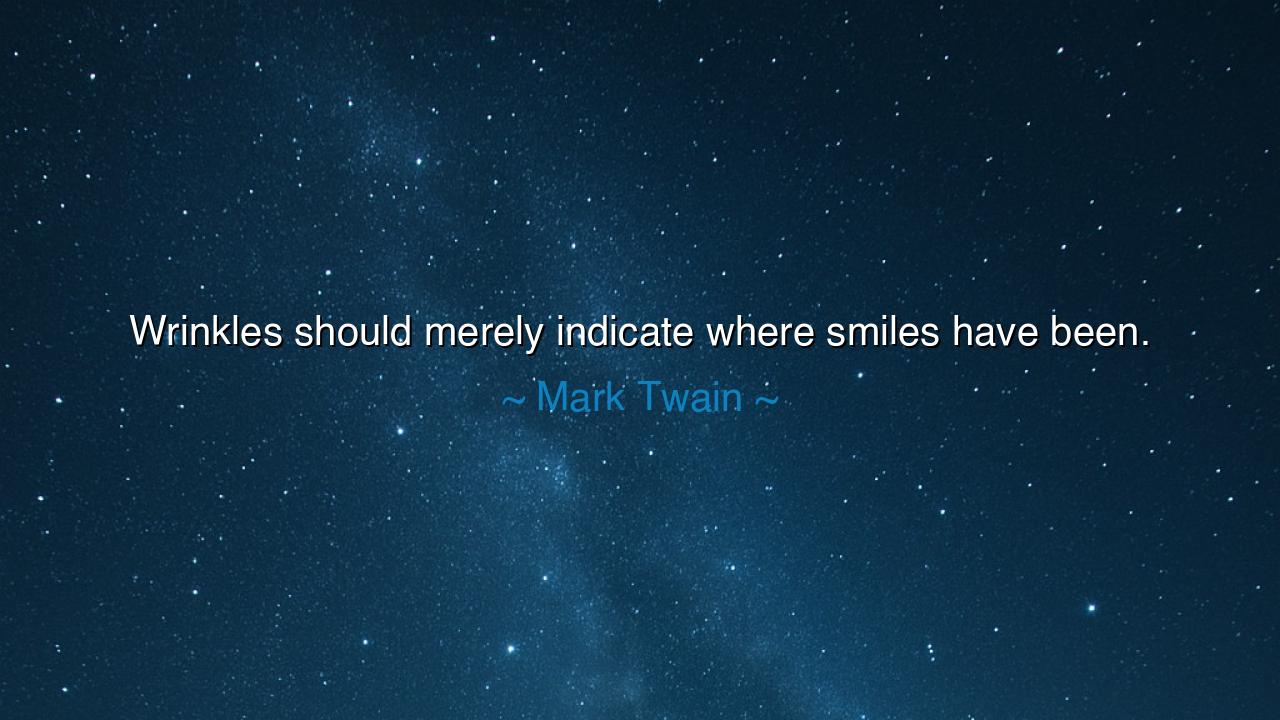
Wrinkles should merely indicate where smiles have been.






"Wrinkles should merely indicate where smiles have been." These words from the inimitable Mark Twain convey a deep and timeless truth about the nature of aging. Twain’s humor, always sharp and insightful, unveils a profound reflection on the passage of time: that wrinkles, often viewed with sorrow or regret, are not simply marks of decline but rather badges of a life lived fully, with joy, laughter, and love. In Twain’s view, each wrinkle is a testament to a smile, a reminder that the face, in its aging, has borne the expression of a spirit that chose to live joyfully. Instead of being ashamed of these marks, we should celebrate them as the signatures of a life well-lived, filled with laughter, connection, and moments of happiness.
In the early years of life, youth is often equated with beauty, smooth skin, and unlined faces. Society places much emphasis on the appearance of youth, urging us to fight against the signs of aging with creams, potions, and treatments, seeking to maintain the illusion of eternal youth. Yet, as Twain so cleverly points out, there is an alternative view of aging that calls us to see the beauty in the lines that mark our faces. Wrinkles are not to be feared or covered up; they should be seen as the physical evidence of a life that has been rich with experiences, emotions, and connections. The faces that bear them have smiled, laughed, cried, and loved. These signs are not to be hidden but to be honored, as they reflect the richness of the life lived behind them.
Consider the life of Mahatma Gandhi, whose face, worn with years of struggle, remains a symbol of strength, wisdom, and peaceful revolution. His wrinkles were not simply marks of age but a reflection of the many battles he fought for justice and the countless smiles he shared with those he liberated. Each line on Gandhi’s face told the story of his commitment to truth, love, and service. His wrinkles were not signs of weakness but of strength, the visible evidence of a life dedicated to the betterment of others. His smile, which was often soft yet powerful, etched its presence in his face and in history. It was not the smoothness of his skin that made him memorable, but the depth of his character, the joy he found in selflessness, and the love he shared with the world. Gandhi’s example reminds us that our wrinkles, like his, should be seen not as imperfections but as symbols of a life well-lived.
Similarly, Queen Elizabeth I of England, though known for her youth and beauty in her early years, aged gracefully, her face marked with the signs of a woman who had ruled a nation through times of great upheaval and strife. Her wrinkles, though a far cry from the smooth skin of her youth, were not marks of failure or decay; they were marks of a monarch’s strength, a ruler who had endured and triumphed. Elizabeth’s face, etched with the wisdom of a lifetime of decisions and hardships, was one that had smiled through triumphs and wept through losses. Her wrinkles, like those of Twain’s metaphor, reflected her smiles, the moments of joy amidst the weight of responsibility, the laughter shared with her close confidants, and the pride in her people’s loyalty. In the case of Elizabeth, as in Twain’s words, the face bears the stories of a life of purpose and dedication.
Mark Twain’s quote calls us to shift our perspective on aging and embrace the signs of time with gratitude rather than sorrow. The wrinkles we accumulate are not just evidence of physical decline, but stories—stories of joy, laughter, and the love we have shared. They are the footprints of a journey that has been rich and filled with meaningful connections. Each smile we have shared, every moment of happiness and laughter, is marked on our faces, not in a way that should cause us shame, but in a way that honors the fullness of life. These lines on our faces are a tribute to the life we have lived and the experiences we have embraced.
The lesson in Twain’s words is one of acceptance and celebration. Aging is inevitable, but we have the power to decide how we experience it. Let us choose to embrace the lines and wrinkles of age as testaments to a life of joy, laughter, and connection. Let us reframe our approach to aging, not as a time to mourn the passing of youth, but as a time to celebrate the wisdom and beauty that comes with experience. Every wrinkle, every line, is a reflection of the smiles we have shared with the world and those we love.
In our own lives, we should actively seek out joy—to laugh deeply, to live fully, and to connect meaningfully with others. Let us live in a way that fills our lives with smiles, so that when our faces eventually bear the marks of time, we can look upon them with pride, knowing that they are not just signs of aging, but signs of a life well-lived. Let us remember that the true beauty of life is not found in the smoothness of our skin, but in the depth of our experiences, the richness of our relationships, and the love we give and receive. In this way, we age not with regret but with grace, knowing that every wrinkle on our face is a celebration of the smiles that have brightened our journey.






AAdministratorAdministrator
Welcome, honored guests. Please leave a comment, we will respond soon